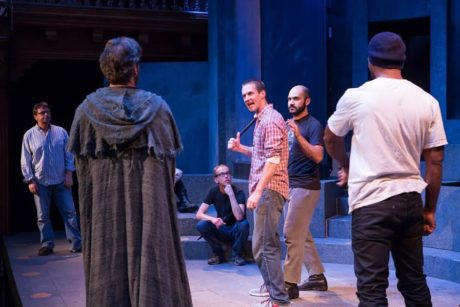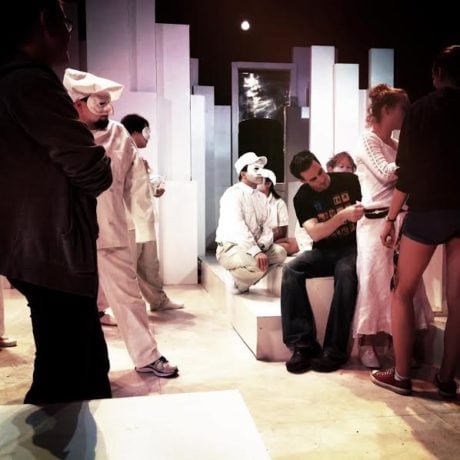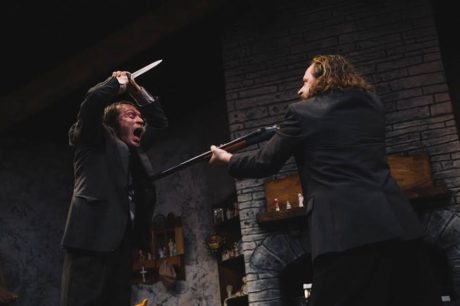How often do we theater-goers find ourselves totally in disbelief when we witness stage violence or physicality? Do you, as I do, find yourself in complete awe of the unnerving movements and actions that seem so real -sometimes just inches from us?
When I read scripts, I often notice that the playwright’s stage directions may only indicate that a “fight” or some sort of physical or perhaps sensual action is to be accomplished. How do only a few written words become visual movement and physicality?
Best to go to a trusted, knowledgeable source to learn.

So, as the new DC area theater season begins in earnest, I took the opportunity to interview Casey Kaleba, a premiere fight choreographer to learn more about the art and craft of theater fight choreography. Chances are, you likely have seen his accomplished work around town at theaters such as Folger, Olney, Round House and Signature to name just a few. Kaleba is a certified teacher with the Society of American Fight Directors, training actors throughout the DC area theater community.
Some of his upcoming 2016-17 season theater projects include The Lonesome West at Keegan Theatre, Jelly’s Last Jam, and Midwestern Gothic at Signature Theatre, as well as the collaborative Angels in America with Round House Theatre and Olney Theatre Center.
With this as a short introduction, my DC Theater Arts interview with Casey Kaleba is right below.

David: How do you make your physical fight/violence choreography look so real?
Casey: I wasted a lot of time early in my career creating choreography alone in my head and then trying to bend the actors to my ideas – it always felt hollow in the end and looked horrible. Now I work harder to create a fight in collaboration with the actors, suited to them and their bodies and their rhythm.
As for realism, I often tend towards choreography that has an unpleasant edge. We’ve become so used to sword fights and Elizabethan death by dagger that I feel we often glaze over when characters are doing truly horrible things to each other. I like to emphasize consequences of violence, which I think ends up feeling more real – as an audience we can’t always identify with the skill of a fighter, but we can all share an understanding of pain.
But realism is not the only measure or goal. A fight can be about joy and playfulness – a Three Musketeers or a Robin Hood – just as much as it can be the gritty shock of a Sarah Kane or McDonagh.
For many shows historical or practical realism just isn’t the right choice. In my classes and in preparation for a show I spend a lot of time in art galleries and thinking about a show’s rhythm, shape, and line. To shape my fights I focus on visual and physical composition – I love the dynamism of art nouveau’s whiplash curve or contrapposto. Those are aspects that can contribute to realism or believability, but also stand on their own as artistic ideas. If you can use an aesthetic tool to create, appreciate, or discuss dance you can do the same with theatrical violence.
What are some of the challenges you face as a Fight Choreographer?
Time. Sight lines. The real challenges are outside the rehearsal room. Like any artist, job instability is a concern – almost every show needs a set designer, but not every show needs a fight director. I’ve been fortunate enough to work full seasons with theatres, but there are years when you look at the season announcement and see that there isn’t any work at that theatre for a whole year.
Another challenge/opportunity is the choose-your-own-adventure aspect of your apprenticeship and training. We don’t have MFA programs in staged combat, and training is often self-directed and self-financed. My training took me to the UK, Canada, and Scandinavia, as well as a dozen US cities…which is to say that my family and my grad school stipend and my credit cards took me to all of those places. The experience, the study, and the exposure to different ideas encourages the development of very individual approaches and aesthetics.

How does an actor’s skill levels in physical fight/violence or experience with weapons affect your work as a Fight Choreographer?
Better trained actors make better fights. There are physically brilliant actors out there, and DC is blessed with equal measures of classical and contemporary theatre that emphasize movement. There’s an exciting circulation of skill and opportunity among theatres, and I think we can see that energy in the work produced on our stages.
However, many actors are cast for attributes beyond their physical abilities, even if the character has to repeatedly fight and be good at it. Tybalt is described as a good fighter, Hamlet has been in constant practice, but the actors playing them may never have picked up a sword in their careers. Often we spend time in rehearsal simultaneously teaching and choreographing while the clock runs down. You wouldn’t cast someone without dance experience in 42nd Street, and then expect the choreographer to teach them to tap while staging the numbers, but that’s exactly what we’re asked to do over and over.
If the fight choreography is really convincing, how can the audience know that the performers themselves are actually safe, not harmed, etc. What does a fight choreographer do to try to make sure that no harm happens?
A significant part of our job is to put characters in danger and keep actors safe. We have extensive protocols in place to achieve this, and we work from a tool kit that emphasizes and reinforces safety. Industry standards have been established by the Society of American Fight Directors, and audiences can generally trust that a performance is professional and safe.
I worked as a theatrical carpenter for several years, and I experienced and saw more injuries in that time than I have in more than twenty years of studying and staging fights. Things do happen, but given the nature of what we do they are remarkable because they are so rare.

Some may be unaware of “fight call” before a performance. Can you explain that?
Before every Equity show – and before responsible non-union shows – there is a fight call. This is a time when the stage is cleared and the actors go through the fights of the show to review and focus on the potentially dangerous scenes of the show. This process is run by a fight captain, usually an actor in the show or the stage manager, who checks in to see if there are any problems or concerns and helps the actors calibrate the fights every night. We often run through the fights several times at different speeds to warm up to show speed, just as actors will do other vocal and physical exercises to prepare for the performance.

Would you provide examples of some of your past DC area fight choreography?
I’ve done a lot of blood in the past few seasons – Titus Andronicus with Faction of Fools, Guards at the Taj with Woolly Mammoth, and The Lieutenant of Inishmore with Constellation. Sweeney Todd is coming up at Olney, and then maybe I can pack the blood cannons away.
I’ve been fortunate enough to work on ambitious shows at the Folger, including Romeo and Juliet, Richard III, and Othello. I pop up in odd places at Signature – working with actors to climb ladders in Miss Saigon all the way up to the gang fights in West Side Story. With Rorschach Theatre I’ve done dragons, pirates, minotaurs, spirits, ninjas, dog soldiers, a monkey, and beasts of London. And at Round House I’ve gotten to swing on ropes in Young Robin Hood, trip over couches in Stage Kiss, bite off hands in Bengal Tiger at the Baghdad Zoo, and slap someone in almost every show.

You can see Casey’s work now in The Keegan Theatre’s The Lonesome West.
The Lonesome West plays through August 27, 2016 at The Keegan Theatre -1742 Church Street, in Washington, DC. For tickets, call the box office at (202) 265-3767, or purchase them online.




